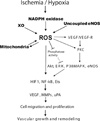Redox balance dynamically regulates vascular growth and remodeling
- PMID: 22634069
- PMCID: PMC4041599
- DOI: 10.1016/j.semcdb.2012.05.003
Redox balance dynamically regulates vascular growth and remodeling
Abstract
Vascular growth and remodeling responses entail several complex biochemical, molecular, and cellular responses centered primarily on endothelial cell activation and function. Recent studies reveal that changes in endothelial cell redox status critically influence numerous cellular events that are important for vascular growth under different conditions. It has been known for some time that oxidative stress actively participates in many aspects of angiogenesis and vascular remodeling. Initial studies in this field were largely exploratory with minimal insight into specific molecular mechanisms and how these responses could be regulated. However, it is now clear that intracellular redox mechanisms involving hypoxia, NADPH oxidases (NOX), xanthine oxidase (XO), nitric oxide and its synthases, and intracellular antioxidant defense pathways collectively orchestrate a redox balance system whereby reactive oxygen and nitrogen species integrate cues controlling vascular growth and remodeling. In this review, we discuss key redox regulation pathways that are centrally important for vascular growth in tissue health and disease. Important unresolved questions and issues are also addressed that requires future investigation.
Copyright © 2012. Published by Elsevier Ltd.
Figures



Similar articles
-
Dual Character of Reactive Oxygen, Nitrogen, and Halogen Species: Endogenous Sources, Interconversions and Neutralization.Biochemistry (Mosc). 2020 Jan;85(Suppl 1):S56-S78. doi: 10.1134/S0006297920140047. Biochemistry (Mosc). 2020. PMID: 32087054 Review.
-
Redox regulation of gasotransmission in the vascular system: A focus on angiogenesis.Free Radic Biol Med. 2017 Jul;108:500-516. doi: 10.1016/j.freeradbiomed.2017.04.025. Epub 2017 Apr 19. Free Radic Biol Med. 2017. PMID: 28433660 Free PMC article. Review.
-
Mitochondrial redox signaling: Interaction of mitochondrial reactive oxygen species with other sources of oxidative stress.Antioxid Redox Signal. 2014 Jan 10;20(2):308-24. doi: 10.1089/ars.2012.4609. Epub 2012 Jul 13. Antioxid Redox Signal. 2014. PMID: 22657349 Free PMC article. Review.
-
Redox-mediated signal transduction by cardiovascular Nox NADPH oxidases.J Mol Cell Cardiol. 2014 Aug;73:70-9. doi: 10.1016/j.yjmcc.2014.02.006. Epub 2014 Feb 19. J Mol Cell Cardiol. 2014. PMID: 24560815 Review.
-
Angiotensin II, NADPH oxidase, and redox signaling in the vasculature.Antioxid Redox Signal. 2013 Oct 1;19(10):1110-20. doi: 10.1089/ars.2012.4641. Epub 2012 Jun 11. Antioxid Redox Signal. 2013. PMID: 22530599 Free PMC article. Review.
Cited by
-
The role of reactive oxygen species in microvascular remodeling.Int J Mol Sci. 2014 Dec 19;15(12):23792-835. doi: 10.3390/ijms151223792. Int J Mol Sci. 2014. PMID: 25535075 Free PMC article. Review.
-
Hemorrhagic transformation after ischemic stroke in animals and humans.J Cereb Blood Flow Metab. 2014 Feb;34(2):185-99. doi: 10.1038/jcbfm.2013.203. Epub 2013 Nov 27. J Cereb Blood Flow Metab. 2014. PMID: 24281743 Free PMC article. Review.
-
The Impact of Aspirin Intake on Lactate Dehydrogenase, Arterial Stiffness, and Oxidative Stress During High-Intensity Exercise: A Pilot Study.J Hum Kinet. 2020 Mar 31;72:101-113. doi: 10.2478/hukin-2019-0101. eCollection 2020 Mar. J Hum Kinet. 2020. PMID: 32269652 Free PMC article.
-
Contribution of increased VEGF receptors to hypoxic changes in fetal ovine carotid artery contractile proteins.Am J Physiol Cell Physiol. 2013 Apr 1;304(7):C656-65. doi: 10.1152/ajpcell.00110.2012. Epub 2013 Jan 16. Am J Physiol Cell Physiol. 2013. PMID: 23325408 Free PMC article.
-
Mitochondrial Regulation of the Muscle Microenvironment in Critical Limb Ischemia.Front Physiol. 2015 Nov 18;6:336. doi: 10.3389/fphys.2015.00336. eCollection 2015. Front Physiol. 2015. PMID: 26635622 Free PMC article. Review.
References
-
- Davis GE, Senger DR. Endothelial extracellular matrix: biosynthesis, remodeling, and functions during vascular morphogenesis and neovessel stabilization. Circulation research. 2005;97:1093–1107. - PubMed
-
- Folkman J. Angiogenesis in cancer, vascular, rheumatoid and other disease. Nat Med. 1995;1:27–31. - PubMed
-
- Babior BM. NADPH oxidase. Curr Opin Immunol. 2004;16:42–47. - PubMed
-
- Ushio-Fukai M. VEGF signaling through NADPH oxidase-derived ROS. Antioxidants & redox signaling. 2007;9:731–739. - PubMed
-
- Jones SA, O'Donnell VB, Wood JD, Broughton JP, Hughes EJ, Jones OT. Expression of phagocyte NADPH oxidase components in human endothelial cells. Am J Physiol. 1996;271:H1626–H1634. - PubMed
Publication types
MeSH terms
Substances
Grants and funding
LinkOut - more resources
Full Text Sources

